# Introduction to Hydraulic Hose End Fittings
Hydraulic systems depend heavily on reliable connections between hoses and equipment. The end fittings on hydraulic hoses are essential for establishing these connections, ensuring that systems function effectively under high pressures without leaks or failures. In this article, we’ll delve into six specific types of hydraulic hose end fittings: crimp fittings, hose barbs, push-lock fittings, quick connects, compression fittings, and reusable fittings. We’ll explore their designs, advantages, and applications to help you determine which fittings best suit your requirements.
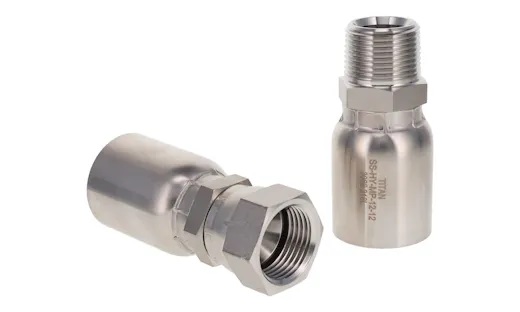
## 1. Crimp Fittings
**Design:** Crimp fittings are permanently attached by using a crimping machine to deform the fitting around the hose, creating a tight seal. These fittings can be made from various materials, including stainless steel, brass, and other alloys.
**Applications:** Due to their robust and leak-resistant seal, crimp fittings are widely used in high-pressure applications like manufacturing, automotive, and heavy machinery. They’re perfect for scenarios where durability and reliability are key, especially when connections aren’t expected to be disconnected frequently.
**Benefits:** Crimp fittings offer a strong, secure connection that’s less prone to leaks compared to other types of fittings. They’re also versatile, available in a wide range of sizes and styles to accommodate different hoses and applications.
[Shop Crimp Fittings](#)
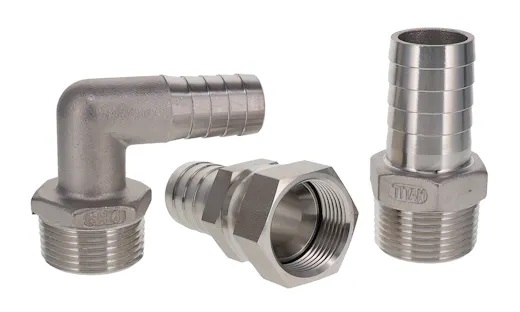
## 2. Hose Barbs
**Design:** Hose barbs are designed with a ridged stem that fits inside the hose. They rely on a snug fit and are often secured with a clamp to keep the hose in place. Installation of hose barbs doesn’t require any special tools, making them a practical choice for quick, on-site repairs.
**Applications:** Hose barbs are commonly used in low to moderate pressure applications, such as in residential water systems, air hoses in workshops, and basic fluid transfer in agriculture.
**Benefits:** The main advantage of hose barbs is their simplicity and ease of installation. They are cost-effective and can be quickly attached without needing heavy machinery or specialized tools.
[Shop Hose Barbs](#)
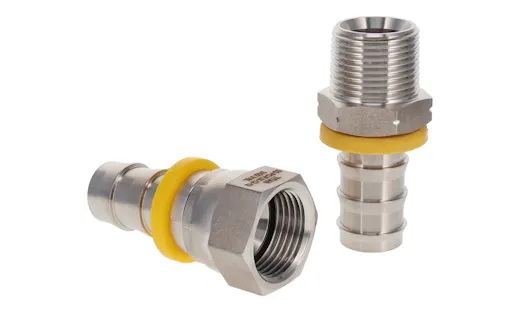
## 3. Push-Lock Barbs
**Design:** Push-lock barbs are designed for easy installation, requiring no tools or clamps. The hose is simply pushed onto the fitting until it locks into place due to an internal gripping ring that secures the hose tightly.
**Applications:** Push-locks are ideal for low-pressure hydraulic and pneumatic systems, such as automotive air systems, as well as water and fluid lines in various industrial settings where quick assembly and disassembly are beneficial.
**Benefits:** The quick and easy installation of push-lock fittings reduces downtime and labor costs. They also provide a clean, professional appearance and are suitable for applications where the system configuration might need to change frequently.
[Shop Push-Lock Barbs](#)
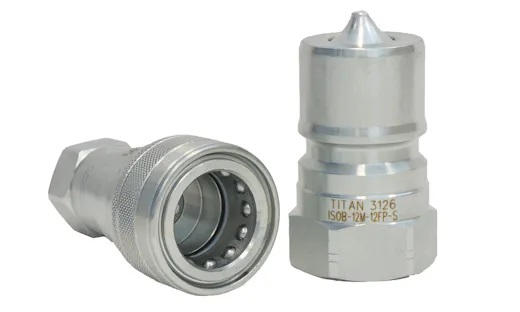
## 4. Quick Connects
**Design:** Quick connect fittings, also known as quick disconnects, feature a simple push-pull coupling mechanism that enables rapid connection and disconnection without tools. They usually consist of a male and female part that lock together securely until intentionally released.
**Applications:** Quick connects are extensively used in applications requiring frequent disconnection and reconnection of hoses, such as in hydraulic machinery in construction and agriculture, as well as in chemical plants where different fluids are transported through the same hoses.
**Benefits:** The primary benefit of quick connect fittings is their ability to significantly reduce downtime when changing or relocating hoses. They also minimize fluid loss during disconnection, making them suitable for handling hazardous or expensive fluids.
[Shop Quick Connects](#)
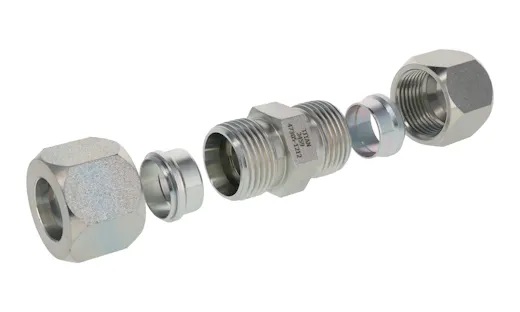
## 5. Compression Fittings
**Design:** Compression fittings use a nut and a ferrule to compress the hose as the nut is tightened, creating a tight seal. This method is straightforward and doesn’t require the hose to be flared.
**Applications:** Ideal for medium-pressure applications, compression fittings are used extensively in hydraulic systems, fuel lines, and refrigeration systems. They are particularly valued in installations where a clean, disassembly-free method is advantageous.
**Benefits:** Compression fittings are known for their excellent leak-proof properties and their ability to be assembled without special tools. They are also highly durable and can be used in environments where the hose requires frequent disassembly and reassembly.
[Shop Compression Fittings](#)

## 6. Reusable Hose Fittings
**Design:** Reusable hose fittings, also known as field-attachable fittings, are designed to be assembled and disassembled without special tools. These fittings typically consist of two or three pieces, including the fitting body, a socket that screws onto the body, and sometimes a nipple. The hose is inserted into the fitting and secured by threading the socket onto the body, compressing the hose between the socket and the nipple or fitting body.
**Applications:** Reusable fittings are ideal for emergency repairs and applications where hoses frequently need to be reconfigured or reused. They are particularly popular in remote field locations, where carrying a crimping tool may be impractical. These fittings are commonly used in marine applications, on-site construction, and in any situation where making quick, effective hose repairs is necessary.
**Benefits:** The primary advantage of reusable fittings is their flexibility and cost-effectiveness. They can be quickly assembled in the field, reducing downtime and eliminating the need for expensive crimping equipment. Additionally, they are a sustainable option, allowing for the reuse of hoses and fittings, which can significantly reduce waste and ongoing costs.
[Shop Reusable Hose Fittings](#)
# Conclusion
Selecting the appropriate hydraulic hose end fitting is vital for ensuring the efficiency, safety, and reliability of hydraulic hose systems. Each type of fitting serves a specific purpose and offers unique benefits. Whether you need the permanence and robustness of crimp fittings, the simplicity of hose barbs, the easy installation of push-lock fittings, the adaptability of quick connects, or the dependability of compression fittings, understanding these options allows you to customize your hydraulic setups to meet the demands of your application.
# Q&A
**Q1: What are hydraulic hose end fittings used for?**
**A1:** Hydraulic hose end fittings are used to connect hoses in a hydraulic system to components like pumps, valves, and cylinders. They ensure secure, leak-free connections capable of handling high pressure and harsh conditions.
**Q2: How do you choose the right hydraulic hose end fitting?**
**A2:** Selecting the right fitting depends on several factors:
- **Pressure requirements:** The fitting must withstand the system’s maximum operating pressure.
- **Compatibility with the hose and fluid:** The materials of the fittings should be compatible with the hydraulic fluid used and the type of hose.
- **Environmental conditions:** Consider factors such as temperature, corrosion potential, and exposure to elements.
- **Application:** The specific use case, like vibration, impulse pressures, and mechanical loads, should influence the fitting type.
**Q3: Can hydraulic hose end fittings be reused?**
**A3:** Some hydraulic hose end fittings, such as reusable or field-attachable fittings, can be reused. These fittings are designed to be assembled without special tools and can be disconnected and reconnected as needed. However, crimp fittings, which are permanently attached, cannot be reused once removed.
**Q4: What is the difference between crimp and reusable fittings?**
**A4:** Crimp fittings are permanently attached to the hose using a crimping machine, which deforms the fitting around the hose to create a tight seal. Reusable fittings, on the other hand, can be manually assembled and disassembled using hand tools. They are not permanently fixed and can be used multiple times.
**Q5: Why would you use a quick connect fitting in a hydraulic system?**
**A5:** Quick connect fittings are used when there is a need for frequent disconnections and reconnections of hoses, without tools, in a hydraulic system. They are ideal for systems that require regular maintenance or where hoses need to be moved or changed out quickly and efficiently, minimizing downtime and fluid loss.
Chemical packaging,Powder packaging,Packing machine,Food packaging machine,Packaging equipment
AGILOR , https://www.agilorpackage.com